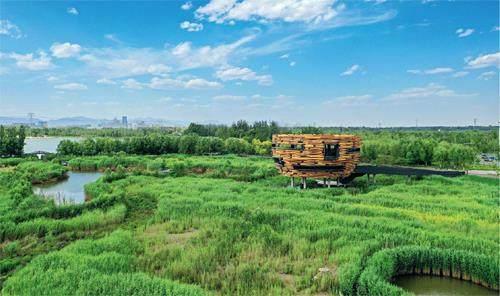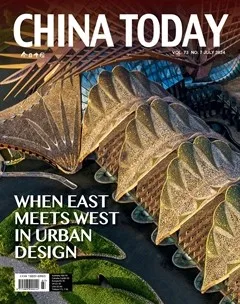A Capital Garden City
ZHOU LIN

CHINESE President Xi Jinping has plantedsaplings in Beijing for over a decade, includingthis year. He has repeatedly said, “Weshould build Beijing into a beautiful gardencity.” Continuing that vision, the Beijing local governmentreleased the Beijing Garden City Plan (2023-2035) recently.
“The plan aims to build Beijing into a livable citythat pursues harmonious coexistence between humansand nature, and a world-renowned capital thatrepresents the countrys high-quality developmentand empowers local communities engagement inpublic affairs,” Shi Xiaodong, chief planner of the BeijingMunicipal Commission of Planning and NaturalResources, said at a press conference on the GardenCity Plan.
Everyone Is a Gardener
The Chinese civilization has always valued harmonybetween humans and nature. It is the foundationof both Beijings historical sites and new culturalclusters. The plan integrates Beijings natural endowments,such as the Taihang and Yanshan mountains,which are the capitals forest barriers, and five majorrivers that run through the city. It has 15 demonstrationregions which best represent the essence ofBeijings landscapes and people. They encompass theold urban residential areas and landmark sites, suchas the Badaling Great Wall, National Olympics SportsCenter, the Future Science City, and the new DaxingInternational Airport.
At the same time, the plan highlights the distinctcharacteristics of the four seasons in Beijing.“We have designed the garden city with four majorthemes in accordance with the colors of the foliage inBeijing. They are fresh and bright green in spring, lushgreen in summer, multicolor in autumn, and snowwhite in winter. Thus, we can create a picturesquecity with its mountains, waters, natural scenery, andcultural heritage throughout the whole year,” Shi said.The plan has also designed ecological landscapes forthe transportation hubs which connect airports, busstations, and train stations, so that travelers from allaround the world will have an impressive green welcome.The green theme is strengthened by urban greenwayswhere people will live and walk under a greencanopy of trees. A greenway network of over 5,000kilometers has been planned, with urban slow trafficsystem, greenways, and waterfront spaces. Over 250boulevards will be afforested to ensure tree shade inthe city. Besides, more parks and green spaces will beencouraged to open to the public to facilitate theireasier access to green getaways.
Shi said the garden sceneries will be closely connectedto peoples life. Therefore, the public will beinvited to participate in their construction and shareideas on improving them. The idea is to create anatmosphere where “everyone is a gardener” and “everyoneis the owner of the garden city.”
History and Hutongs
Ma Qinghong, deputy director of the BeijingMunicipal Commission of Housing and Urban-RuralDevelopment, says urban renewal is a key task inthe plan. Urban renewal means not only retrofittingbuildings but also enhancing urban functionsto make the city more livable. The Garden City Plancombines urban renewal with garden city building tocreate a greener, more livable, and ecological capitalfor a big country.
The Liangmahe International Style WaterfrontProject is an exemplary project. Located in Beijingspopular Chaoyang District, it maintains the ancientcapitals distinct features with a modern and fashionablelifestyle. Weeping willows and swaying reeds along the Liangmahe River forma beautiful frame around a bayof clear water and a wharf dottedwith fountains and cascadingwaterfalls. This is a thrivingleisure destination with its restaurantsand cafés teeming withyoung people, children playing and riding their bikesand others enjoying the scenery. This harmoniouspicture has been achieved due to the environmentalimprovements in recent years.
“Green ecology is the top priority in the constructionof a garden city,” Ma said. The Liangmahe projectstarted with the transformation and improvementof this urban waterfront area and its green spaces,creating an 18-kilometer waterfront greenway, whichprovides quality leisure space for the public. The convenientgreenway has also become a business clusterfor nighttime culture and tourism consumption,boosting the capitals consumption capability.
Since Beijing is a historical city that has been a cultural center for thousands of years, there is a special stress on preserving its cultural heritage. Li Rugang,deputy director of the Beijing Municipal Commissionof Urban Management, said 60 of Beijings mostbeautiful streets and alleys have been spruced up.Last year, 20 routes to explore the most beautiful alleyswere created for explorers to experience Beijingsunique cultural charms.
The 850-meter Dashilan Historical and CulturalDistrict route includes four boutique streets andalleys. It passes through popular intangible culturalheritage sites, including the Daguanlou Cinema, QingyungePagoda, and the Beijing-Hangzhou GrandCanal. Additionally, visitors can check out the iconicfashion shopping center of Sanlitun in ChaoyangDistrict, and the historical Lugou Bridge near ancientWanping Town in southwest Beijing.
A major feature of Beijings urban constructionis the culture of hutongs , traditional alleyways withsingle-storied residences built around a courtyard. Ma said they have launched “micro gardens” in the alleys,which combine courtyard greening and architecture,preserving the climbing vines, flower pots, and flowerracks. The green plantings on walls, or vertical gardenscreate a refreshing environment.
With the renovation of alleys and courtyards, thehistorical and cultural characteristics of old Beijingare being showcased with a new vitality.
Parks without Borders
A garden city will enhance the diversity, stability,and sustainability of the ecosystem, achievingharmonious coexistence between humans andnature. According to Lian Guozhao, deputy directorof the Beijing Municipal Forestry and ParksBureau, Beijing has over 600 species of terrestrialwild vertebrates, including 519 species of birds,which shows the effectiveness of its biodiversityconservation work.
In addition, the area of forests accounts for 44.9percent of the capital citys total area. “By 2025, itsforest stock volume will be 34.5 million cubic meters,with an annual carbon sink capacity of 10 milliontons,” Lian said.
“Pocket parks,” small and micro green spaces, and“boundless parks” are the new highlights in the constructionof the garden city. Lian said by 2035, the percapita green area in parks will reach 17 square metersand over 95 percent of residents will have a greenspace within a 500-meter radius.
“Boundless parks,” as the name suggests, are parkswithout fences which are open to the public 24 hoursa day, so that the “last 500 meters” on peoples wayhome are green as well. More than 100 “boundlessparks” have been renovated in Haidian and Chaoyangdistricts.
The Yuan Dadu City Wall Ruins Park is the firstboundless park in Beijing. The park was built in 1988to preserve the walls of ancient Beijing when it wasthe capital of the Yuan Dynasty (1271-1368). After thefences were dismantled, shrubs were replanted andpublic facilities built, with the area near the sidewalktiled and displaying flower windows. The seats at thebus stop there have been designed like a leaf withveins.
Livable Waterfront
Ecological protection and water conservation arekey in the construction of garden cities. Yang Jinhuai,deputy director of the Beijing Water Authority, saidthe quality of the water of the Miyun Reservoir innortheast Beijing has always maintained the ClassII standard for drinking water resource. Various birdspecies, such as herons and spotted sand ducks, buildtheir nests and rear their young ones there and thewater ecology is improving.
It was recently announced that a cultural andtourism scenic spot will be built in Tongzhou, Beijingssubcenter, by 2025. It will revolve round theBeijing (Tongzhou) GrandCanal that was a bustling tradeand culture route in the past.Visitors can set off from theCanal Culture Square, visit theancient architectural complex,see the lighthouse and then take a boat southward to the natural oxygen bar – theGrand Canal Forest Park. It is one of the 11 sprawlingriverside forest parks in Beijing.
Today, riverside and lakeside spaces have becomeimportant public spaces for showcasingurban charm and diverse cultures. Yang said thecitys “green lung,” the Wenyuhe Park, has an areaof about 30 square kilometers. It has multiplefunctions. Besides being a leisure park, it is alsoan animal and plant conservation and flood storageand detention area. In addition, the park hasformed 12 million square meters of flood controlareas, improving the flood control capacity of thebasin area.
The Garden City Plan promises more waterfrontspaces, landscape improvement projects,waterfront walkways, new ice rinks, and areas forkayaking and doing other water sports. By 2035,the length of the river with a waterfront slowtraffic system is expected to reach 550 kilometers,creating an urban landscape of a waterfrontgarden with a blue sky, green scenery, and clearwater.

